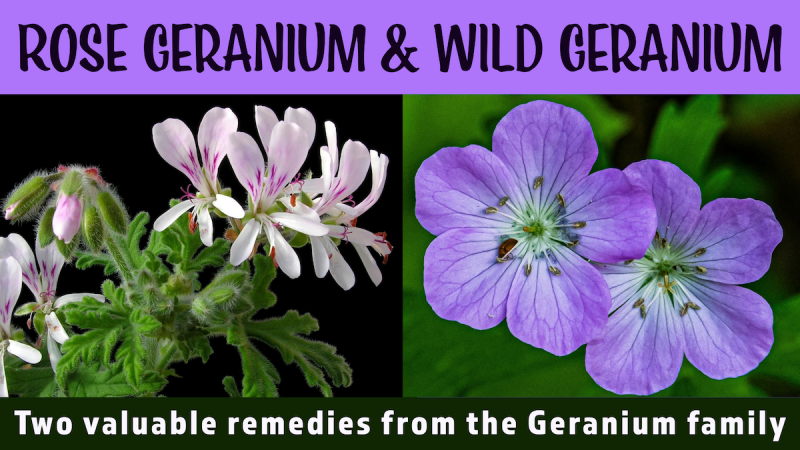
My mother always had a few geraniums around the home and my wife does, too. They don’t tolerate the cold, but they’re easy to grow in a pot that can be placed outdoors in the summer and brought indoors in the winter. These types of geranium are grown for their flowers and fragrance and are also called scented geraniums because they emit strong odors when the leaves are bruised.
Scented geraniums are members of the geranium family, but they aren’t true geraniums. They belong to the Pelargonium genus and it’s the essential oil from them that is used in herbal medicine. According to Wikipedia, there are around 250 species in this genus, but the one commonly used for its essential oil is Pelargonium graveolens, also known as rose geranium.
True geraniums belong to the Geranium genus and they’re the ones that are used as herbs. The most commonly used species here is Geranium maculatum, but other species have also been used medicinally including the three species of wild geraniums that grow here in Utah, Richardson’s geranium (G. richardsonii), sticky geranium (G. viscossissimum), and Pineywoods geranium (G. caespitosum). I’ve seen and photographed all three species in the wilds, although I’ve never harvested them.
Native American Ethnobotany by Daniel E. Moerman lists all these species as being used by native Americans, plus five more. In this article, I'll go over the medicinal uses of plants from both genera, the true geraniums, and the scented geraniums. But we'll start with the essential oil from P. graveolens.
Geranium Essential Oil
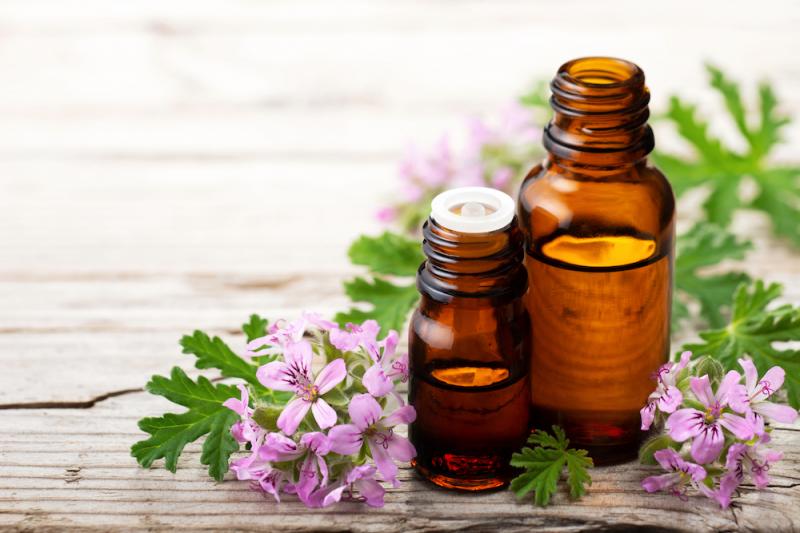 The essential oil of geranium is fresh, floral, herbaceous, and slightly sweet. (I explain these categories in my video, Energetics of Herbalism and Aromatherapy.) I consider it an ethereal remedy, one that has moistening, cooling, and mind-opening effects.
The essential oil of geranium is fresh, floral, herbaceous, and slightly sweet. (I explain these categories in my video, Energetics of Herbalism and Aromatherapy.) I consider it an ethereal remedy, one that has moistening, cooling, and mind-opening effects.
Geranium essential oil (EO) has an estrogenic effect. When applied topically or inhaled it can help ease PMS, depression associated with menopause, heavy bleeding during periods, and vaginal dryness. It can be helpful for menopause, especially for easing hot flashes because of its cooling effects.
Geranium EO also has some great properties that make it useful for wound healing. It is analgesic, anti-inflammatory, antiseptic, antiviral, cicatrisant, styptic, and vulnerary, It also acts as a lymphatic stimulant and can be applied to relieve lymphatic stagnation, fluid retention, and swelling, while reducing pain and inflammation. With both analgesic and antispasmodic properties, it is useful for nerve, eye, and joint pain.
Emotional Effects of Geranium EO
Geranium EO also helps to calm the mind and relax the body. It reduces emotional heat as well as physical inflammation, helping to cool down fiery, stress-filled emotions like irritability and frustration. It has a balancing effect on the nervous system which makes it helpful for both depression and anxiety. It also helps a person release negativity and overcome apathy and confusion and may be a helpful oil for people who have been abused or traumatized.
Geranium helps stress in people who are workaholics or whose perfectionist attitudes drive them into anxiety. Because it has an ethereal effect, due to its fresh, herbaceous qualities, it can help to open up the creative mind, aiding imagination and intuition to help someone find creative solutions to their problems. It also aids sensory awareness, which helps on connect more deeply with life.
Using Geranium Essential Oil
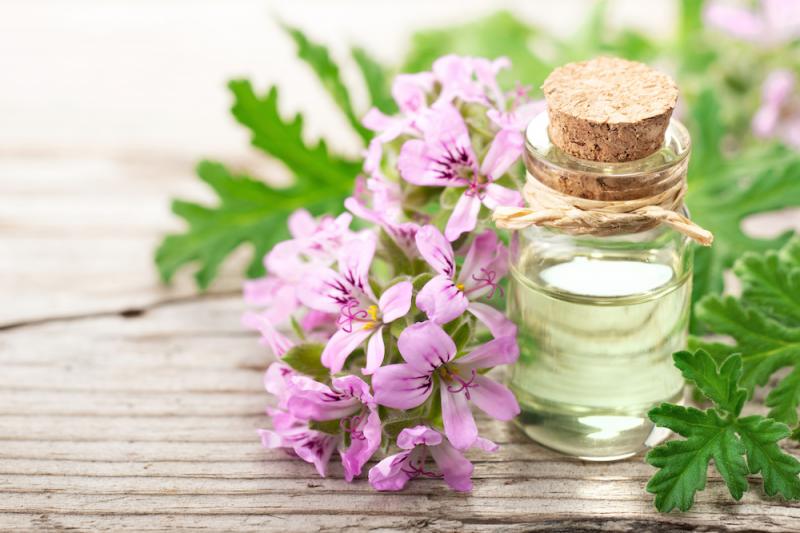 Geranium essential oil should not be used internally. It can be applied topically either neat or diluted. It can also be diffused or made into an aerosol for inhalation, or you can smell it directly out of the bottle.
Geranium essential oil should not be used internally. It can be applied topically either neat or diluted. It can also be diffused or made into an aerosol for inhalation, or you can smell it directly out of the bottle.
My naturopathic business associate and friend Kimberly Balas gave me her recipe for a hot flash spray which uses both geranium and clary sage.
Mix the following into a small spray bottle:
- Two ounces of water
- 4 drops Rose or Geranium Essential Oil
- 3 drops Lavender Essential Oil
- 2 drops Clary Sage Essential Oil
- 2 drops Peppermint Essential Oil
When you’re experiencing a hot flash shake thoroughly and mist around your face to help you cool down.
If you have a larger spray bottle you can scale the recipe. For example, if you're mixing up four ounces of spray then double the amount of drops.
Wild Geranium or Cranesbill
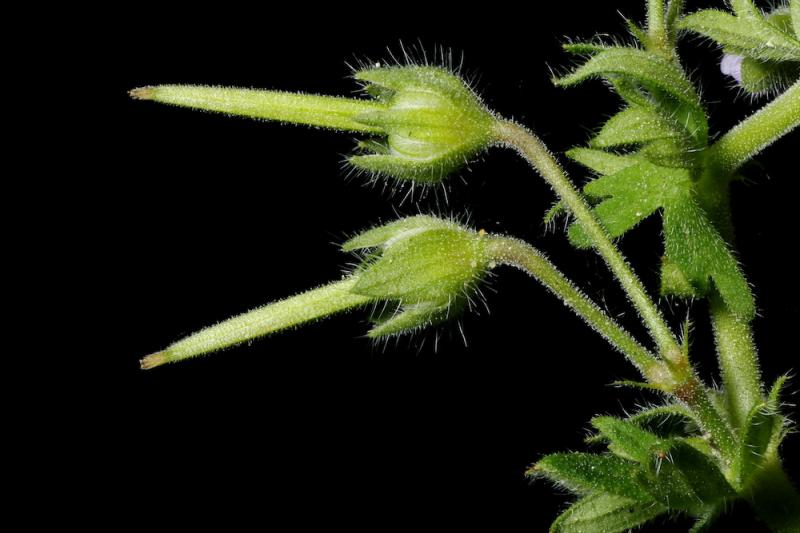 Wild geranium or cranesbill are very different plants from the Pelargonium species used for their essential oils. To avoid confusion we'll refer to the herbal remedies, from the Geranium genus, as cranesbill. The name cranesbill comes from the seed pods, which are long and pointy. An example from the species Geranium pusillum is pictured right. The flowers of cranesbill (Geranium maculatum is pictured below) are very different from the geraniums people grow for flowers.
Wild geranium or cranesbill are very different plants from the Pelargonium species used for their essential oils. To avoid confusion we'll refer to the herbal remedies, from the Geranium genus, as cranesbill. The name cranesbill comes from the seed pods, which are long and pointy. An example from the species Geranium pusillum is pictured right. The flowers of cranesbill (Geranium maculatum is pictured below) are very different from the geraniums people grow for flowers.
Cranesbills are strong astringents and used for similar purposes as white oak bark or bayberry rootbark, but they are not as widely available commercially. The primary part used is the roots, which are dug in the fall, but you can also use the leaves and stems.
Cranesbill can be applied topically to help stop bleeding and heal various types of sores or wounds. This includes bruises, black eyes, bedsores, and skin ulcerations. A decoction can be used as a gargle or mouthwash for canker sores, bleeding gums, and excess mucus in the throat. The powder can also be snuffed for nosebleeds and nasal polyps. It can also be applied as a salve or ointment for hemorrhoids.
Using Cranesbill
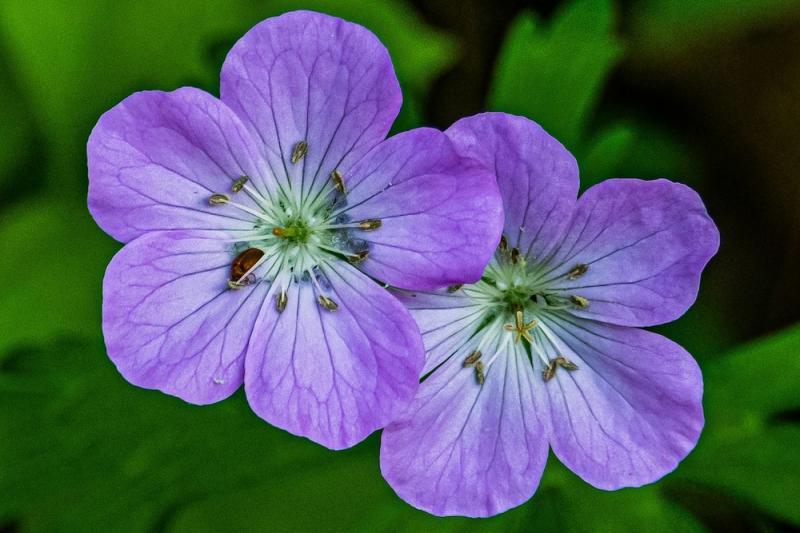 To harvest cranesbill, dig the roots in the fall and dry them. The dried roots can be powdered or made into a 1:5 tincture.
To harvest cranesbill, dig the roots in the fall and dry them. The dried roots can be powdered or made into a 1:5 tincture.
You can sprinkle cranesbill root powder onto wounds or apply the freshly crushed leaves to help stop bleeding and speed healing. The tincture can also be applied topically to wounds.
Cranesbill can be taken internally to tone up a weakened or prolapsed uterus and ease heavy menstrual bleeding. It can also aid the healing of peptic and duodenal ulcers, arrest watery diarrhea, and reduce excess mucous discharge. Take 5-50 drops of the tincture as needed.
However, avoid taking a strong astringent, like cranesbill, internally for more than a week or two. Also, nursing mothers should avoid cranesbill as it can dry up breast milk.
Steven's Articles
-

-
The Sensible Use of Caffeinated Herbs
Kola nuts, guarana, and yerba mate and other herbs…
-

-
The Health Benefits and Problems with Coffee
This popular caffeinated beverage can be beneficial…
October
-

-
Understanding Caffeine & Cellular Adaptation
Preserving the power of caffeine's buzz and the…
September
-

-
Horseradish
A pungent spice for aiding protein metabolism…
-

-
Banaba or Crepe Myrtle
A beautiful tree from Southeast Asia whose leaves…
August
-

-
Monkeyflowers
Flower essences to help see ourselves more clearly…
-

-
Mariposa Lilies
Strengthening the bond between mother and child…
-

-
The Noble Bay Leaf
A common kitchen herb for aiding digestion and…
-

-
Epimedium: Horny Goat Weed
A circulatory stimulant and kidney yang tonic…
July
-

-
The Medicinal and Nutritional Benefits of Apricots
A nutritious fruit and valuable medicinal seed for coughs
-

-
Dogwoods
Asian dogwood is used to stop excessive discharge,…
June
-

-
Neem: The Village Pharmacy
A popular Ayurvedic remedy for dental and immune…
-

-
Spilanthes: The Toothache Plant
A traditional remedy for teeth and gums, as well…
-

-
Forsythia
An anti-inflammatory, fever-reducing, and infection fighting herb
May
-

-
Buckwheat (Kashi)
A delicious, high protein, gluten-free, gut-healthy food

